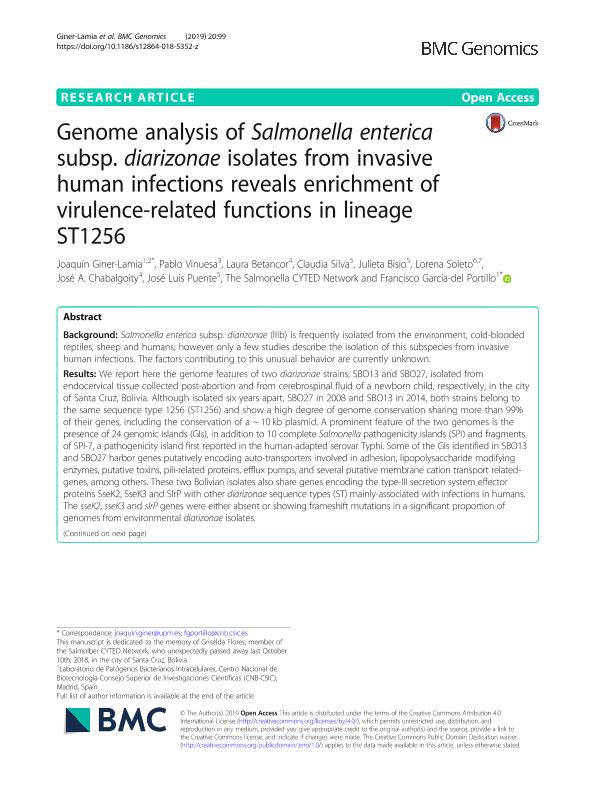Mostrar el registro sencillo del ítem
dc.contributor.author
Giner Lamia, Joaquín
dc.contributor.author
Vinuesa, Pablo
dc.contributor.author
Betancor, Laura

dc.contributor.author
Silva, Claudia
dc.contributor.author
Bisio, Julieta
dc.contributor.author
Soleto, Lorena
dc.contributor.author
Chabalgoity, José A.
dc.contributor.author
Puente, José Luis
dc.contributor.author
Soncini, Fernando Carlos

dc.contributor.author
Garcia Vescovi, Eleonora

dc.contributor.author
García Del Portillo, Francisco
dc.date.available
2022-02-03T18:45:56Z
dc.date.issued
2019-01
dc.identifier.citation
Giner Lamia, Joaquín; Vinuesa, Pablo; Betancor, Laura; Silva, Claudia; Bisio, Julieta; et al.; Genome analysis of Salmonella enterica subsp. diarizonae isolates from invasive human infections reveals enrichment of virulence-related functions in lineage ST1256; BioMed Central; BMC Genomics; 20; 1; 1-2019; 1-14
dc.identifier.issn
1471-2164
dc.identifier.uri
http://hdl.handle.net/11336/151306
dc.description.abstract
Background Salmonella enterica subsp. diarizonae (IIIb) is frequently isolated from the environment, cold-blooded reptiles, sheep and humans; however only a few studies describe the isolation of this subspecies from invasive human infections. The factors contributing to this unusual behavior are currently unknown. Results We report here the genome features of two diarizonae strains, SBO13 and SBO27, isolated from endocervical tissue collected post-abortion and from cerebrospinal fluid of a newborn child, respectively, in the city of Santa Cruz, Bolivia. Although isolated six years apart, SBO27 in 2008 and SBO13 in 2014, both strains belong to the same sequence type 1256 (ST1256) and show a high degree of genome conservation sharing more than 99% of their genes, including the conservation of a ~ 10 kb plasmid. A prominent feature of the two genomes is the presence of 24 genomic islands (GIs), in addition to 10 complete Salmonella pathogenicity islands (SPI) and fragments of SPI-7, a pathogenicity island first reported in the human-adapted serovar Typhi. Some of the GIs identified in SBO13 and SBO27 harbor genes putatively encoding auto-transporters involved in adhesion, lipopolysaccharide modifying enzymes, putative toxins, pili-related proteins, efflux pumps, and several putative membrane cation transport related-genes, among others. These two Bolivian isolates also share genes encoding the type-III secretion system effector proteins SseK2, SseK3 and SlrP with other diarizonae sequence types (ST) mainly-associated with infections in humans. The sseK2, sseK3 and slrP genes were either absent or showing frameshift mutations in a significant proportion of genomes from environmental diarizonae isolates. Conclusions The comparative genomic study of two diarizonae strains isolated in Bolivia from human patients uncovered the presence of many genes putatively related to virulence. The statistically-significant acquisition of a unique combination of these functions by diarizonae strains isolated from humans may have impacted the ability of these isolates to successfully infect the human host.
dc.format
application/pdf
dc.language.iso
eng
dc.publisher
BioMed Central

dc.rights
info:eu-repo/semantics/openAccess
dc.rights.uri
https://creativecommons.org/licenses/by-nc-sa/2.5/ar/
dc.subject
COMPARATIVE GENOMICS
dc.subject
INVASIVE HUMAN INFECTIONS
dc.subject
SALMONELLA ENTERICA
dc.subject
SUBSPECIES DIARIZONAE
dc.subject
TYPE-III EFFECTORS
dc.subject
VIRULENCE GENES
dc.subject.classification
Biología Celular, Microbiología

dc.subject.classification
Ciencias Biológicas

dc.subject.classification
CIENCIAS NATURALES Y EXACTAS

dc.title
Genome analysis of Salmonella enterica subsp. diarizonae isolates from invasive human infections reveals enrichment of virulence-related functions in lineage ST1256
dc.type
info:eu-repo/semantics/article
dc.type
info:ar-repo/semantics/artículo
dc.type
info:eu-repo/semantics/publishedVersion
dc.date.updated
2020-11-25T18:00:51Z
dc.journal.volume
20
dc.journal.number
1
dc.journal.pagination
1-14
dc.journal.pais
Reino Unido

dc.journal.ciudad
Londres
dc.description.fil
Fil: Giner Lamia, Joaquín. Consejo Superior de Investigaciones Científicas; España. Universidad Politécnica de Madrid; España
dc.description.fil
Fil: Vinuesa, Pablo. Universidad Nacional Autónoma de México; México
dc.description.fil
Fil: Betancor, Laura. Universidad de la República; Uruguay
dc.description.fil
Fil: Silva, Claudia. Universidad Nacional Autónoma de México; México
dc.description.fil
Fil: Bisio, Julieta. Universidad Nacional Autónoma de México; México
dc.description.fil
Fil: Soleto, Lorena. Universidad Autónoma Gabriel René Moreno; Bolivia. Ministerio de Salud de Bolivia. Centro Nacional de Enfermedades Tropicales; Bolivia
dc.description.fil
Fil: Chabalgoity, José A.. Universidad de la República; Uruguay
dc.description.fil
Fil: Puente, José Luis. Universidad Nacional Autónoma de México; México
dc.description.fil
Fil: Soncini, Fernando Carlos. Consejo Nacional de Investigaciones Científicas y Técnicas. Centro Científico Tecnológico Conicet - Rosario. Instituto de Biología Molecular y Celular de Rosario. Universidad Nacional de Rosario. Facultad de Ciencias Bioquímicas y Farmacéuticas. Instituto de Biología Molecular y Celular de Rosario; Argentina
dc.description.fil
Fil: Garcia Vescovi, Eleonora. Consejo Nacional de Investigaciones Científicas y Técnicas. Centro Científico Tecnológico Conicet - Rosario. Instituto de Biología Molecular y Celular de Rosario. Universidad Nacional de Rosario. Facultad de Ciencias Bioquímicas y Farmacéuticas. Instituto de Biología Molecular y Celular de Rosario; Argentina
dc.description.fil
Fil: García Del Portillo, Francisco. Consejo Superior de Investigaciones Científicas; España
dc.journal.title
BMC Genomics

dc.relation.alternativeid
info:eu-repo/semantics/altIdentifier/url/https://bmcgenomics.biomedcentral.com/articles/10.1186/s12864-018-5352-z
dc.relation.alternativeid
info:eu-repo/semantics/altIdentifier/doi/http://dx.doi.org/10.1186/s12864-018-5352-z
Archivos asociados
